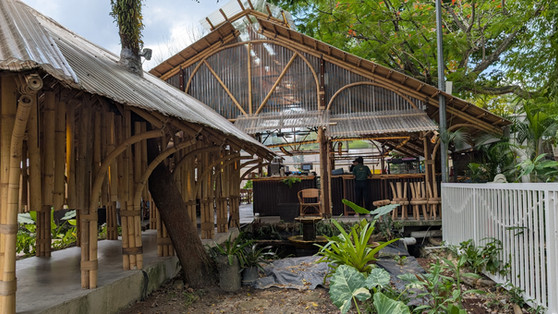Bamboo as a building material
- Alia Meor
- Aug 8, 2025
- 8 min read
Malaysia’s building sector
The building sector is one of the major contributors to carbon emission. According to International Energy Association’s 2020 World Energy Statistics and Balances, the building sector contributes to 38% of global emissions, and 26% of these emissions comes from embodied carbon in buildings. Embodied carbon refers to the greenhouse gas emissions associated with the manufacturing, transportation, construction, and disposal of building materials and infrastructure. The rapid increase of carbon dioxide (CO2) will lead to the rise of global warming and climate change.
Construction activities are considered the major contributor to the embodied carbon. This includes the depletion of non-renewable resources and the destruction of landscapes. In addition, the construction industry consumes large quantity of environmental resources. Furthermore, there are four sources of GHG emissions in construction of buildings, which are; the manufacture and transportation of building materials, energy consumption of construction equipment, energy consumption of processing resources and disposal of construction wastes.
Steel, glass, aluminium, plastics and concrete have significant carbon and environmental footprints. Use of natural materials like timber and bamboo can significantly lessen the environmental impact of what we build. With proper utilization, they can even have a negative embodied carbon. To have an effective impact on decarbonization, more focus needs to be given to the choice of building materials. In order to lower the amount of embodied carbon in the built environment, bamboo presents itself as a greener alternative compared to non-renewable, carbon-intensive materials such as cement and metal. So how can we switch to greener buildings materials like bamboo?
Bamboo to replace construction materials
Instead of continuously extracting resources and taking from the earth, we can shift into a more cultivating ideology, in the sense that we grow our own construction materials. Yes, we can grow our own building materials! Living in a tropical country, we are blessed with the abundance of one of the most sustainable building materials in the world: Bamboo. Malaysia is home to at least 70 species of bamboo and at least 7 or 8 of the species are suitable for construction. Among the commonly used bamboo in Malaysia are buluh duri (Bambusa blumeana), buluh gading (Bambusa vulgaris), buluh betong (Dendrocalamus asper), buluh beting (Gigantochloa levis), and buluh semantan (Gigantochloa scortechinii).
SEAD – Stewards of Environmentally-Aware Development
In one of the Malaysian states called Perak, the company Stewards of Environmentally-Aware Development (SEAD) recognizes the numerous benefits bamboos can provide and are working with this magnificent grass plant to resolve some of the major environmental issues present in the state. SEAD is currently focused on restoration of degraded tin-mining lands, providing a sustainable solution for the built environment and also rural community empowerment. The bamboo species planted by SEAD is Dendrocalamus asper (buluh betong).


Bamboo properties
Other than being the fastest growing plant in the world, bamboo is also one of the few species that are able to thrive on degraded land, further contributing to its restoration. The resilience of bamboo is a great solution for the idle lands in Perak that were once tin mining sites. It is estimated that Perak have about 30,000 hectares of former tin mining lands that are no longer in use and the soil in these areas have been polluted with toxic chemicals and deprived of its nutritional contents. Such degraded lands prevents most plant species to grow healthily and biodiversity is lost. Bamboo, being a highly resilient plant species, is one of the few species that can grow in these polluted and degraded soil. The bamboo rhizomes help to stabilise the soil content and provide a supportive environment for other plant species, which is crucial to the regeneration of the degraded ex-tin mining lands found throughout Perak and transform them into functional ecosystems. SEAD recognizes the regenerative capabilities of bamboo and are currently working to restore 20 hectares of land by planting the resilient bamboo plant together with the vetiver plant, whose deeper roots combine well with the shallower root system of bamboo.

The bamboo plant is strong, versatile and regenerative as it can be harvested continuously in a sustainable manner. Cutting bamboo can stimulate further growth when harvested correctly, leading to increased yields over time. Bamboo also allows for frequent harvesting without the need for replanting. This regenerative feature makes bamboo a superior alternative to timber and rates of deforestation can be reduced. Besides, bamboo can still sequester carbon even after it is harvested, because the root system continues to grow, making it a potentially carbon-negative plant.
Biochar for soil enhancement
SEAD also incorporates biochar into the soil as fertilizer for their bamboo plantation. Biochar is the product of heating waste biomass (e.g. bamboo) in the absence of oxygen. The carbon-rich biochar is highly stable and can sequester carbon when applied as a soil enhancer. Biochar boosts the carbon content of the soil, restores the soil quality, and creates air-pockets that help increase the water-holding capacity and creates an inviting habitat for beneficial microbes.

Adding biochar into degraded soils can drive an exponential increase in the microbial population that is critical to the soil fertility. Moreover, biochar creates a carbon sink in the soil. Instead of carbon being released as carbon dioxide into the atmosphere, the carbon is stored in the ground and is stabilized in a solid state. According to a National Geographic article in September 2008, the geographer and soil scientist William I, Woods from University of Kansas found that biochar soils has 10 or 20 times more carbon than typical tropical soils because the carbon is stored a much greater depth and can remain there for hundreds of years.
CASE STUDY: Biochar in Thailand
Khomchalat Thongting from Thailand, founder of Wongphai, grows bamboo in Thailand and produces various products, especially biochar. Wongphai has become the first biochar producer in Thailand to achieve certification under the European Biochar Certificate (EBC) standard. They also contribute to verified Carbon Dioxide Removal (CDR) in compliance with the Carbon Standards International (CSI) framework. IEN had the wonderful opportunity of meeting the founder and listening to the inspiring journey of Wongphai 2 years ago. He has bamboo plantations in the East of Bangkok and exports bamboo sticks treated for construction to Europe. Wongphai also sells carbon credits for businesses to offset their carbon footprint by leveraging sustainable solutions like biochar and afforestation. The carbon credits are sold for $189.99 per tonne of CO2 saved; where 1 ton of sequestered CO2 from bamboo bio-char leads to a 3-fold carbon storage in the soil.
Bamboo in sustainable construction
So the question is, how can bamboo be a substitute for sustainable construction? First of all, bamboo is incredibly strong and light weight. Bamboo’s tensile strength is comparable to steel. In conventional buildings, steel is placed into concrete as a reinforcement to enhance the concrete’s tensile strength. With bamboo’s natural ability to withstand high tensile forces, it can potentially replace steel reinforcement bars in building construction. One snag, however, is the different contraction rate of bamboo and concrete. Over time, when bamboo dries inside a concrete slab, it may contract so much that the physical contact between bamboo and concrete is largely lost, which poses a problem; research is ongoing to address this challenge. The compressive strength of structural materials is also important. Although bamboo has generally lower compressive strength than steel, it can still outperform many other materials like wood, brick, and concrete.
Material | Compressive strength (MPa) |
Brickwork | 14 |
Portland concrete (28 days old) | 35 |
Spruce wood | 43 |
Bamboo (bambusa vulgaris) | 78 |
Steel | 250 |
Bamboo’s strength and flexibility allows it to effectively absorb seismic activity better compared to more common building materials. For instance, in 1991, Costa Rica was struck with an earthquake with a 7.6 magnitude on the Richter Scale, and a collection of bamboo houses had little to no damage while wood and concrete houses in the same area suffered damage.
Prefabricated Bamboo Houses
SEAD uses the “LEGO concept” for their bamboo construction projects. The concept is rooted in modularity, prefabrication, and flexible joinery, instead of the conventional method of interlocking plastic blocks. The building pieces are precision‑cut off‑site and will be delivered in a container ready to assemble on-site. Each piece is tailored to work like modular units, much like building blocks, and can be assembled in 3 days into a house without any skilled labour. This building concept allows disassembly and reassembly as needed—imitating the reusable nature of LEGO pieces. As the components are modular and joinery is reversible, structures can be easily expanded, modified, relocated, or recycled. Along with that, SEAD offers a 10-year warranty for the termite resistant bamboo that they provide in construction projects.

Using bamboo as a building material can also lower the costs for construction, making it cost-effective and more accessible especially for low-cost housing projects. It’s versatility also allows bamboo to be used for various applications other than structural elements like roofs, floors, walls, and also furniture. The lightweight property of bamboo also makes it easier and cheaper to transport, shape, and work with. On top of that, bamboo’s natural appeal provides great aesthetics and enhances the buildings’ visual. Just take a look at the Teja Luna bamboo pavilion project in Ipoh, Perak:


Bamboo Building Standards
With all the facts and research done towards the viability of bamboo to replace building materials in construction, it’s easy to imagine the stretch of companies already adopting this into their projects. However, it is not that simple. A lot of the researchers and pioneers of the bamboo incentive describe it to be a chicken-and-egg situation. The absence of policies on the adoption of bamboo as a building material discourages wider commercialization. Without official building standards and codes condoning the use of structural bamboo, there are a lot of reluctance for architects and engineers to utilize bamboo into their projects.

To put it simply, there is lack of demand for bamboo as a building material. This discourages investment in its availability and supply chains, while the lack of reliable supply prevents the demand and adoption of this method/material for building construction. This creates a cycle where neither demand nor supply can grow without the other taking the first step. Hence that is why, SEAD is taking the first step to providing the supply and kick-starting the construction of bamboo projects to prove its viability and commercial success of this practice to local authorities. The future of bamboo construction is promising with SEAD working alongside local authorities to include bamboo as a building material in our local standards and policies for the building industry. SEAD is part of a consortium working for the adoption of the bamboo structures standard ISO 22156 in Malaysia, presumably by mid-2026. With support and heightened awareness within local authorities, stakeholders and developers, we can surely move forward to incorporate sustainable material into the building construction projects.

Acknowledgements
Thank you to Mr. Ooi from the Malaysia Green Building Council (malaysiaGBC) Northern Chapter for arranging this 1-day study tour. Likewise, many thanks to Lucas Loo, executive director of SEAD, for hosting us, both at the Center of Rehabilitated Ecosystems (CoRE), and at the Teja Luna bamboo pavilion at private land in Ipoh.
References & Contributions:
https://www.e3s-conferences.org/articles/e3sconf/pdf/2014/02/e3sconf_etsdc2014_01016.pdf
https://www.nst.com.my/news/2015/09/perak-turn-ex-tin-mines-growth-centres
https://planboo.eco/wongphai-and-planboo-bring-biochar-to-thailand/
“Mechanical properties of different bamboo species”, Awalluddin et. al. (2017)
Conversations with Khomchalat Thongting (founder of Wongphai)
Contributions / editing by Gregers Reimann (IEN Consultants)
Gallery






































